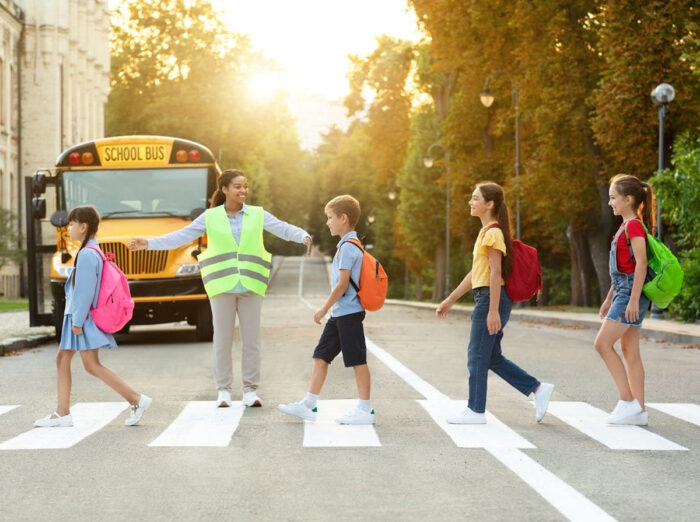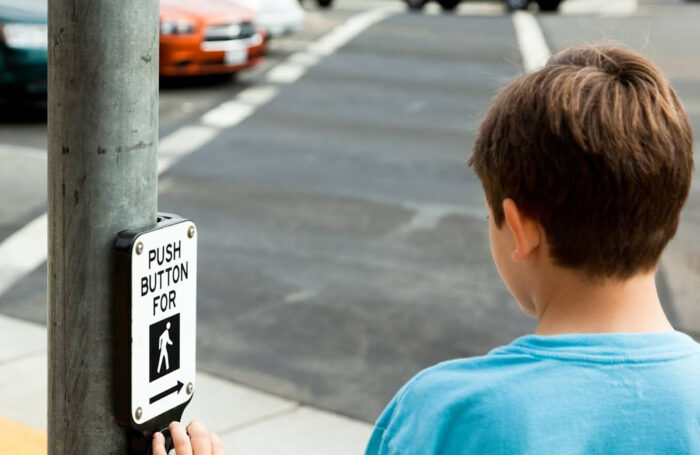Pedestrian Safety
Children tend to mimic the adults in their lives, so it’s important to set a good example for children learning pedestrian safety. It’s equally important to talk to children about how to be safe while walking and teach road safety basics as young as possible.

Always be aware when walking near or crossing a road.
The Facts
Unintentional pedestrian injuries are the 5th highest cause of injury-related death for children ages 5 to 19.
Teens are at a higher risk with a death rate twice that of younger children.
Safety Tips for Walkers
Adhering to simple pedestrian safety measures is important and they can help keep everybody safe.

Adults should always cross with children under age 10.
Children do not have the ability to determine the speed and distance of approaching cars until that point in their development.

It’s safest to walk on sidewalks and cross streets using marked crosswalks whenever available.
If there is no sidewalk, walk facing traffic so you can see what’s coming.

Obey traffic signals.
such as the Walk and Don’t Walk signs.

Look left, right, and left again
before crossing the road. It is important to look in all directions.
It’s simple, but essential!

Make eye contact with the driver.
When pedestrians cross the road they should make eye contact with drivers, watch out for cars turning or backing out, and refrain from darting out into the road.

Put your phone and other devices down when you are crossing the street.
This allows your attention to be on any hazards on the road. Teach children to be aware of their surroundings, including people who appear to be distracted.
Safety Tips for Drivers
Pay Special Attention to Non-Driving Road Users
when driving, including walkers, runners and bicyclists. Be especially alert in residential neighborhoods and school zones.
Give Pedestrians the Right of Way and Look Both Ways
when making a turn to help spot any bicyclists, walkers or runners who may not be immediately visible.
Put Phones and Other Electronics Out of Reach
so there are no distractions.
Be Careful
Enter and exit gaps in the sidewalk carefully.
Backover Incidents
A backover incident typically takes place when a car is backing out of a driveway or parking space. Every week in the United States, 50 children are backed over due to a driver being unable to see them.
Children of all ages can be backed over.
Children Younger than 5 Years Old
are at the highest risk.
12-23 Months
is the predominant age of backover victims. Toddlers in this age group have just started walking/running at this age, testing the limits and trying new things.
In Over 70% of Backover Incidents
a parent or close relative is the driver behind the wheel.
Bye-Bye Syndrome™
is a contributing factor and happens when children don’t want to be left behind when they hear the words ‘bye-bye’. Many times, children follow behind the person who is leaving. The driver is unaware and thinks they are still safe inside. The child stands behind the vehicle where they cannot be seen and is backed over.
Be cautious when backing up!
Be aware that every vehicle has blind zones behind, on the sides, and in front where the driver cannot see even when looking back and using their rear and side view mirrors correctly.
Create habits
to ensure children are directly supervised every time someone is arriving or leaving the home. This is when most tragedies occur.
Walk completely around your vehicle
scanning the area for children and pets before moving a vehicle. If you see or hear children, be sure they are directly supervised by an adult.
Rearview cameras can be installed on any vehicle to help end these predictable tragedies.



